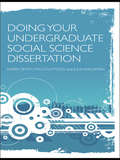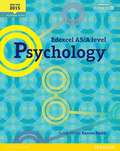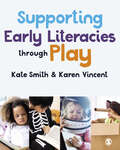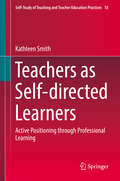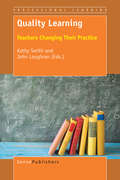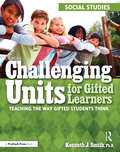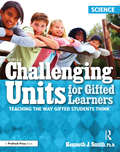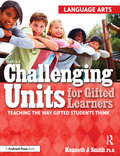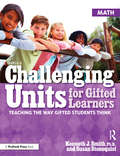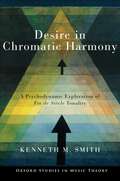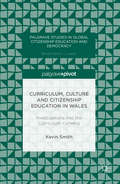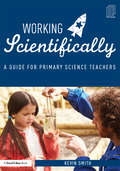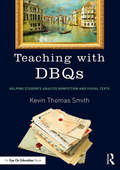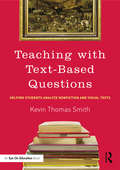- Table View
- List View
Doing Your Undergraduate Social Science Dissertation: A Student’s Handbook
by Karen Smith Malcolm J. Todd Julia WaldmanAre you a final year social science student who has to do a dissertation or final year project? Do you have no idea where to start? If so, Doing Your Undergraduate Social Science Dissertation is the book for you, covering the whole dissertation journey from project planning to submission. Using a mixture of useful information, exercises, practical strategies, case study material and further reading, it helps you through the process, giving hints and tips on beginning and managing your research project and working with your supervisors. Packed with proven practical advice, it also identifies many other sources of information and resources, making it your most dependable starting point and guide on your dissertation journey. Also included are links to accompanying materials on the Routledge website. The authors have extensive experience in teaching at all levels in the social sciences, supervising social science undergraduates and dissertations.
Doing Your Undergraduate Social Science Dissertation: A Student’s Handbook
by Karen Smith Malcolm J. Todd Julia WaldmanAre you a final year social science student who has to do a dissertation or final year project? Do you have no idea where to start? If so, Doing Your Undergraduate Social Science Dissertation is the book for you, covering the whole dissertation journey from project planning to submission. Using a mixture of useful information, exercises, practical strategies, case study material and further reading, it helps you through the process, giving hints and tips on beginning and managing your research project and working with your supervisors. Packed with proven practical advice, it also identifies many other sources of information and resources, making it your most dependable starting point and guide on your dissertation journey. Also included are links to accompanying materials on the Routledge website. The authors have extensive experience in teaching at all levels in the social sciences, supervising social science undergraduates and dissertations.
Edexcel AS/A Level Psychology Student Book + Activebook (PDF)
by Karren Smith Susan Harty James Bailey Elizabeth Barkham Esther O'Neill Anna Cave Annabel JervisExam Board: Edexcel Level: AS and A level Subject: Psychology First teaching: September 2015 First exams: June 2017 (2016 for AS) This Student Book + ActiveBook covers both the Edexcel AS and A level Psychology courses from 2015 and will help you to: develop greater confidence in the practical application of relevant psychology and mathematical skills (for example data handling, analysis and application) through the use of in-depth explanations and worked examples understand the requirements of assessment through dedicated Exam Preparation content which reflects the linear nature of the new qualification develop the knowledge and skills that will be required in Higher Education through a focus on further research, independent enquiry and extended writing think more like a psychologist, making links between themes within the book and exploring the synoptic nature of the course through the new 'Thinking Bigger' and 'Wider Issues and Debates' features. The ActiveBook gives you easy online access to the textbook content so you don't have to carry the book to and from school or college. You can make it your own with notes, highlights and links to wider reading - perfect for supporting coursework and revision activities.
Supporting Early Literacies through Play
by Kate Smith Karen VincentBringing together two key areas within early childhood— play and literacy — this book offers an innovative approach to examining literacies within the context of children’s play. This book: Introduces students to contemporary theory and research in the field Explores the debates surrounding young children’s play and how language and literacies are created through a range of play activity Helps students to reflect on how this knowledge can be applied in their future professional lives working to support young children Advocating for young children’s play and diverse literacies, this book supports students to develop a depth of knowledge about how play can extend children’s literacies, and encourages early childhood educators to reflect on and enhance their literacy practices with young children.
Supporting Early Literacies through Play
by Kate Smith Karen VincentBringing together two key areas within early childhood— play and literacy — this book offers an innovative approach to examining literacies within the context of children’s play. This book: Introduces students to contemporary theory and research in the field Explores the debates surrounding young children’s play and how language and literacies are created through a range of play activity Helps students to reflect on how this knowledge can be applied in their future professional lives working to support young children Advocating for young children’s play and diverse literacies, this book supports students to develop a depth of knowledge about how play can extend children’s literacies, and encourages early childhood educators to reflect on and enhance their literacy practices with young children.
Supporting Early Literacies through Play
by Kate Smith Karen VincentBringing together two key areas within early childhood— play and literacy — this book offers an innovative approach to examining literacies within the context of children’s play. This book: Introduces students to contemporary theory and research in the field Explores the debates surrounding young children’s play and how language and literacies are created through a range of play activity Helps students to reflect on how this knowledge can be applied in their future professional lives working to support young children Advocating for young children’s play and diverse literacies, this book supports students to develop a depth of knowledge about how play can extend children’s literacies, and encourages early childhood educators to reflect on and enhance their literacy practices with young children.
Teachers as Self-directed Learners: Active Positioning through Professional Learning (Self-Study of Teaching and Teacher Education Practices #18)
by Kathleen SmithThis book redefines teacher in-service education as being less about participation in a program and more about the opportunity for teachers to experience a process of learning that is personally meaningful and contextually relevant to their own teaching practice. The research presented here reveals that teachers have the capacity to think and work differently, yet are rarely provided with opportunities to exercise active decision-making about their personal learning needs. Creating and implementing such an approach involves reimagining all aspects of the learning experience so that teachers are free to articulate their own learning needs and actively work to determine what matters most for their professional practice.The book breaks new ground by drawing from research related to an in-service program where teachers, their experience and professional thinking were deliberately positioned at the centre of the learning experience. Using this evidenced-based approach, it focuses not only on the learning achieved, but also the conditions that enabled teachers to undertake such learning.
Quality Learning: Teachers Changing Their Practice (Professional Learning)
by Kathy Smith John LoughranWhen teachers are supported to work together in ways that allow them to deepen knowledge of their professional practice, the understandings that emerge from their conversations about quality learning and teaching demonstrate a high level of expertise. Yet such professional knowledge is often deeply embedded within each teacher’s everyday teaching; the tacit knowledge that determines how and why they attend to student learning in certain ways. This book captures the professional knowledge of teachers that developed as the result of an ongoing process of school based change, where teachers began to work differently because they began to think differently about the learning that mattered for their students in their school. The explication of their knowledge of practice became possible due to the ongoing support they received from their school leadership – in most part because leadership trusted them as professionals to responsibly lead student learning. Within this culture of trust and valued collaboration, working alongside external critical friends who supported their professional learning, the teachers engaged in regular, thought provoking and interactive professional dialogue. Together they exposed and challenged each other’s thinking and beliefs about learning and teaching, captured and examined each other’s practice and, ultimately articulated and extended their professional knowledge. The insights about this collaborative learning process and the emergent knowledge and understandings teachers develop about the interactive relationship between learning and teaching, has much to contribute to educational discourse beyond the school setting. Some of that knowledge and the way it looks in practice is shared in this book.
Challenging Units for Gifted Learners: Teaching the Way Gifted Students Think (Social Studies, Grades 6-8)
by Kenneth J. SmithGifted students have the potential to learn material earlier and faster, to handle more complexity and abstraction, and to solve complex problems better. This potential, however, needs stimulating experiences from home and school or it will not unfold. The books in the Challenging Units for Gifted Learners series are designed to help teachers provide the stimulating curricula that will nurture this potential in school. The units presented in this series are based on research into how these students actually think differently from their peers and how they use their learning styles and potential not merely to develop intellectual expertise, but to move beyond expertise to the production of new ideas.The Social Studies book includes units that ask students to explore the struggles of America's first permanent English settlement in Jamestown, to hold an African economic summit, to study various Supreme Court cases and primary source documents, and to create a Civil War documentary that views the war from the perspective of a person living in a particular state. Grades 6-8
Challenging Units for Gifted Learners: Teaching the Way Gifted Students Think (Science, Grades 6-8)
by Kenneth J. SmithGifted students have the potential to learn material earlier and faster, to handle more abstraction, and to solve complex problems better. This potential, however, needs stimulating experiences from home and school or it will not unfold. These books are designed to help teachers provide the engaging curricula that will nurture this potential in school. The Science book includes a medical simulation in which teams of students work as doctors to diagnose patients' cases, a food science project in which students use a variety of information-gathering techniques to learn how nutrition impacts performance, a hands-on study of human memory and expertise, and a study of the physics of sports.Grades 6-8
Challenging Units for Gifted Learners: Teaching the Way Gifted Students Think (Language Arts, Grades 6-8)
by Kenneth J. SmithGifted students have the potential to learn material earlier and faster, to handle more complexity and abstraction, and to solve complex problems better. This potential, however, needs stimulating experiences from home and school or it will not unfold. The books in the Challenging Units for Gifted Learners series are designed to help teachers provide the stimulating curricula that will nurture this potential in school. The units presented in this series are based on research into how these students actually think differently from their peers and how they use their learning styles and potential not merely to develop intellectual expertise, but to move beyond expertise to the production of new ideas.The Language Arts book includes units that ask students to develop strong personalities for their main characters while writing mysteries, to study Freud's psychoanalytic theory and then analyze a classic novel using what they've learned, to focus on writing from a specific point of view, and to increase their appreciation for poetry by studying famous poets. Grades 6-8
Challenging Units for Gifted Learners: Teaching the Way Gifted Students Think (Science, Grades 6-8)
by Kenneth J. SmithGifted students have the potential to learn material earlier and faster, to handle more abstraction, and to solve complex problems better. This potential, however, needs stimulating experiences from home and school or it will not unfold. These books are designed to help teachers provide the engaging curricula that will nurture this potential in school. The Science book includes a medical simulation in which teams of students work as doctors to diagnose patients' cases, a food science project in which students use a variety of information-gathering techniques to learn how nutrition impacts performance, a hands-on study of human memory and expertise, and a study of the physics of sports.Grades 6-8
Challenging Units for Gifted Learners: Teaching the Way Gifted Students Think (Social Studies, Grades 6-8)
by Kenneth J. SmithGifted students have the potential to learn material earlier and faster, to handle more complexity and abstraction, and to solve complex problems better. This potential, however, needs stimulating experiences from home and school or it will not unfold. The books in the Challenging Units for Gifted Learners series are designed to help teachers provide the stimulating curricula that will nurture this potential in school. The units presented in this series are based on research into how these students actually think differently from their peers and how they use their learning styles and potential not merely to develop intellectual expertise, but to move beyond expertise to the production of new ideas.The Social Studies book includes units that ask students to explore the struggles of America's first permanent English settlement in Jamestown, to hold an African economic summit, to study various Supreme Court cases and primary source documents, and to create a Civil War documentary that views the war from the perspective of a person living in a particular state. Grades 6-8
Challenging Units for Gifted Learners: Teaching the Way Gifted Students Think (Language Arts, Grades 6-8)
by Kenneth J. SmithGifted students have the potential to learn material earlier and faster, to handle more complexity and abstraction, and to solve complex problems better. This potential, however, needs stimulating experiences from home and school or it will not unfold. The books in the Challenging Units for Gifted Learners series are designed to help teachers provide the stimulating curricula that will nurture this potential in school. The units presented in this series are based on research into how these students actually think differently from their peers and how they use their learning styles and potential not merely to develop intellectual expertise, but to move beyond expertise to the production of new ideas.The Language Arts book includes units that ask students to develop strong personalities for their main characters while writing mysteries, to study Freud's psychoanalytic theory and then analyze a classic novel using what they've learned, to focus on writing from a specific point of view, and to increase their appreciation for poetry by studying famous poets. Grades 6-8
Challenging Units for Gifted Learners: Teaching the Way Gifted Students Think (Math, Grades 6-8)
by Kenneth J. Smith Susan StonequistGifted students have the potential to learn material earlier and faster, to handle more complexity and abstraction, and to solve complex problems better. This potential, however, needs stimulating experiences from home and school or it will not unfold. These books are designed to help teachers provide the stimulating curricula that will nurture this potential in school. The units presented in this series are based on research into how these students actually think differently from their peers and how they use their learning styles and potential not merely to develop intellectual expertise, but to move beyond expertise to the production of new ideas.The Math book includes units that ask students to develop a financial portfolio that includes high- and low-risk stocks, options and margins, AAA and junk bonds, mutual funds, and money markets; use math, science, engineering, technology, and art to design and build a miniature golf course; develop games based on probability; and run a real-life small business.Grades 6-8
Challenging Units for Gifted Learners: Teaching the Way Gifted Students Think (Math, Grades 6-8)
by Kenneth J. Smith Susan StonequistGifted students have the potential to learn material earlier and faster, to handle more complexity and abstraction, and to solve complex problems better. This potential, however, needs stimulating experiences from home and school or it will not unfold. These books are designed to help teachers provide the stimulating curricula that will nurture this potential in school. The units presented in this series are based on research into how these students actually think differently from their peers and how they use their learning styles and potential not merely to develop intellectual expertise, but to move beyond expertise to the production of new ideas.The Math book includes units that ask students to develop a financial portfolio that includes high- and low-risk stocks, options and margins, AAA and junk bonds, mutual funds, and money markets; use math, science, engineering, technology, and art to design and build a miniature golf course; develop games based on probability; and run a real-life small business.Grades 6-8
Desire in Chromatic Harmony: A Psychodynamic Exploration of Fin de Siècle Tonality (Oxford Studies in Music Theory)
by Kenneth M. SmithHow does musical harmony engage listeners in relations of desire? Where does this desire come from? Author Kenneth Smith seeks to answer these questions by analyzing works from the turn of the twentieth- century that are both harmonically enriched and psychologically complex. Desire in Chromatic Harmony yields a new theory of how chromatic chord progressions direct the listener on intricate journeys through harmonic space, mirroring the tensions of the psyche found in Schopenhauer, Freud, Lacan, Lyotard, and Deleuze. Smith extends this mode of enquiry into sophisticated music theory, while exploring philosophically engaged European and American composers such as Richard Strauss, Alexander Skryabin, Josef Suk, Charles Ives, and Aaron Copland. Focusing on harmony and chord progression, the book drills down into the diatonic undercurrent beneath densely chromatic and dissonant surfaces. From the obsession with death and mourning in Suk's asrael Symphony to an exploration of "perversion" in Strauss's elektra; from the Sufi mysticism of Szymanowski's Song of the Night to the failed fantasy of the American dream in Copland's The Tender Land, Desire in Chromatic Harmony cuts a path through the dense forests of chromatic complexity, revealing the psychological make-up of post-Wagnerian psychodynamic music.
Desire in Chromatic Harmony: A Psychodynamic Exploration of Fin de Siècle Tonality (Oxford Studies in Music Theory)
by Kenneth M. SmithHow does musical harmony engage listeners in relations of desire? Where does this desire come from? Author Kenneth Smith seeks to answer these questions by analyzing works from the turn of the twentieth- century that are both harmonically enriched and psychologically complex. Desire in Chromatic Harmony yields a new theory of how chromatic chord progressions direct the listener on intricate journeys through harmonic space, mirroring the tensions of the psyche found in Schopenhauer, Freud, Lacan, Lyotard, and Deleuze. Smith extends this mode of enquiry into sophisticated music theory, while exploring philosophically engaged European and American composers such as Richard Strauss, Alexander Skryabin, Josef Suk, Charles Ives, and Aaron Copland. Focusing on harmony and chord progression, the book drills down into the diatonic undercurrent beneath densely chromatic and dissonant surfaces. From the obsession with death and mourning in Suk's asrael Symphony to an exploration of "perversion" in Strauss's elektra; from the Sufi mysticism of Szymanowski's Song of the Night to the failed fantasy of the American dream in Copland's The Tender Land, Desire in Chromatic Harmony cuts a path through the dense forests of chromatic complexity, revealing the psychological make-up of post-Wagnerian psychodynamic music.
Curriculum, Culture and Citizenship Education in Wales: Investigations into the Curriculum Cymreig (Palgrave Studies in Global Citizenship Education and Democracy)
by Kevin SmithThis book explores how culture and citizenship are theorised, promoted and learned throughout schools in Wales. Following a brief history of Welsh education and a discussion of how contemporary cultural identity is theorised through citizenship education curricula, it illustrates how archaic approaches to understanding cultural identity continue to undermine the development of culturally relevant curriculum in Wales. Smith also analyses how young people discuss their orientations to Welshness, how teachers engage with the requirements of the Curriculum Cymreig and how these reactions develop within educational settings. Ending with a recommendation for a more sophisticated framework for conceptualising identity and a critical approach for discussing citizenship and cultural identity in schools in Wales, this book highlights how the critical pedagogy can progress further.
Working Scientifically: A guide for primary science teachers
by Kevin SmithWith the changes that have taken place to the National Curriculum for science, the investigations that children should experience have broadened and become a key part of the curriculum necessary for the development of knowledge and understanding. Working Scientifically is a comprehensive guide that will help primary teachers develop their skills, improve their practice and nurture ‘working scientifically’ in the classroom. This book provides teachers with the tools and resources that are necessary for teaching science in a fun and exploratory way. Focusing on individual skills, it provides scientific activities in a number of different contexts. It explores each skill multiple times to help pupils progress through the age-related expectations and emphasises teaching through exploration, questioning and dialogue. Using the analogy of a journey to space as the central concept, with each step of progression related to a step in the journey, chapters include: What is ‘working scientifically’? Raising questions, predictions and planning; Observations, measurements and recording; Interpreting, analysing and concluding; Reflecting and evaluating; Assessment. Full of practical resources such as planning materials and assessment sheets, Working Scientifically will be an essential guide for all qualified and trainee primary teachers wishing to develop their practice in this essential area of the Science curriculum.
Working Scientifically: A guide for primary science teachers
by Kevin SmithWith the changes that have taken place to the National Curriculum for science, the investigations that children should experience have broadened and become a key part of the curriculum necessary for the development of knowledge and understanding. Working Scientifically is a comprehensive guide that will help primary teachers develop their skills, improve their practice and nurture ‘working scientifically’ in the classroom. This book provides teachers with the tools and resources that are necessary for teaching science in a fun and exploratory way. Focusing on individual skills, it provides scientific activities in a number of different contexts. It explores each skill multiple times to help pupils progress through the age-related expectations and emphasises teaching through exploration, questioning and dialogue. Using the analogy of a journey to space as the central concept, with each step of progression related to a step in the journey, chapters include: What is ‘working scientifically’? Raising questions, predictions and planning; Observations, measurements and recording; Interpreting, analysing and concluding; Reflecting and evaluating; Assessment. Full of practical resources such as planning materials and assessment sheets, Working Scientifically will be an essential guide for all qualified and trainee primary teachers wishing to develop their practice in this essential area of the Science curriculum.
Teaching with DBQs: Helping Students Analyze Nonfiction and Visual Texts
by Kevin Thomas SmithHelp your students navigate complex texts in history and social studies. This book shows you how to use document-based questions, or DBQs, to build student literacy and critical thinking skills while meeting rigorous state standards and preparing students for AP exams. DBQs can be implemented year-round and can be adjusted to meet your instructional needs. With the helpful advice in this book, you’ll learn how to use DBQs to teach nonfiction and visual texts, including primary and secondary sources, maps, and paintings. You’ll also get ideas for teaching students to examine different points of view and write analytical responses. Topics include: Using the SOAPSETone (Speaker, Occasion, Audience, Purpose, Subject, Evidence and Tone) technique to to analyze visual and nonvisual texts; Teaching students to distinguish between primary and secondary sources; Working with multiple texts and learning to recognize the relationships between them; Formulating DBQs to suit different types of assessment, including short-answer questions, multiple-choice questions, and in-class essay prompts; Evaluating student responses and providing constructive feedback.
Teaching with DBQs: Helping Students Analyze Nonfiction and Visual Texts
by Kevin Thomas SmithHelp your students navigate complex texts in history and social studies. This book shows you how to use document-based questions, or DBQs, to build student literacy and critical thinking skills while meeting rigorous state standards and preparing students for AP exams. DBQs can be implemented year-round and can be adjusted to meet your instructional needs. With the helpful advice in this book, you’ll learn how to use DBQs to teach nonfiction and visual texts, including primary and secondary sources, maps, and paintings. You’ll also get ideas for teaching students to examine different points of view and write analytical responses. Topics include: Using the SOAPSETone (Speaker, Occasion, Audience, Purpose, Subject, Evidence and Tone) technique to to analyze visual and nonvisual texts; Teaching students to distinguish between primary and secondary sources; Working with multiple texts and learning to recognize the relationships between them; Formulating DBQs to suit different types of assessment, including short-answer questions, multiple-choice questions, and in-class essay prompts; Evaluating student responses and providing constructive feedback.
Teaching With Text-Based Questions: Helping Students Analyze Nonfiction and Visual Texts
by Kevin Thomas SmithHelp your students navigate complex texts in history/social studies and English language arts! This book shows you how to use a key tool—text-based questions—to build students’ literacy and critical thinking skills and meet the Common Core State Standards. You’ll learn how to ask text-based questions about different types of nonfiction and visual texts, including primary and secondary sources, maps, charts, and paintings. You’ll also get ideas for teaching students to examine point of view, write analytical responses, compare texts, cite textual evidence, and pose their own high-level questions. The book is filled with examples that you can use immediately or modify as needed. Each chapter ends with a reflection section to help you adapt the ideas to your own classroom. What’s Inside: Helpful information on teaching different types of nonfiction texts, including literary nonfiction, informational texts, primary and secondary sources, and visual texts Ideas for locating primary sources Questions students should ask about every text Techniques for soliciting higher-order questions from students Ways to get students to think critically about the relationships between texts Strategies to help students integrate information from different types of sources, a skill that will help students respond to performance tasks on the PARCC and SBAC assessments and DBQs on AP exams Tips for teaching students to write good responses to text-based questions, including how to cite sources and incorporate point of view Ideas for using rubrics and peer grading to evaluate students’ responses Connections to the informational reading standards of the Common Core State Standards for English Language Arts for grades 3-12 and of the Common Core State Standards for Literacy in History/Social Studies, Science, and Technical Subjects
Teaching With Text-Based Questions: Helping Students Analyze Nonfiction and Visual Texts
by Kevin Thomas SmithHelp your students navigate complex texts in history/social studies and English language arts! This book shows you how to use a key tool—text-based questions—to build students’ literacy and critical thinking skills and meet the Common Core State Standards. You’ll learn how to ask text-based questions about different types of nonfiction and visual texts, including primary and secondary sources, maps, charts, and paintings. You’ll also get ideas for teaching students to examine point of view, write analytical responses, compare texts, cite textual evidence, and pose their own high-level questions. The book is filled with examples that you can use immediately or modify as needed. Each chapter ends with a reflection section to help you adapt the ideas to your own classroom. What’s Inside: Helpful information on teaching different types of nonfiction texts, including literary nonfiction, informational texts, primary and secondary sources, and visual texts Ideas for locating primary sources Questions students should ask about every text Techniques for soliciting higher-order questions from students Ways to get students to think critically about the relationships between texts Strategies to help students integrate information from different types of sources, a skill that will help students respond to performance tasks on the PARCC and SBAC assessments and DBQs on AP exams Tips for teaching students to write good responses to text-based questions, including how to cite sources and incorporate point of view Ideas for using rubrics and peer grading to evaluate students’ responses Connections to the informational reading standards of the Common Core State Standards for English Language Arts for grades 3-12 and of the Common Core State Standards for Literacy in History/Social Studies, Science, and Technical Subjects
